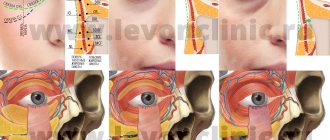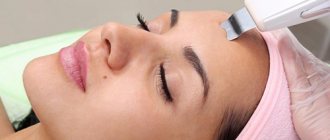Why do bruises appear under the eyes: anatomical features
The skin under the lower eyelid is several times thinner than on other parts of the body and contains a large number of blood vessels and small capillaries. And the vessels, capillaries, and muscles that are located under the epidermis are darker than our skin, so if they are visible, visually it will look like bruises under the eyes. The effect also occurs when the permeability of the walls of blood vessels and capillaries is disrupted.
The lower layer of the epidermis is subcutaneous fat. In some areas of our body (for example, the border of the lips) it is completely absent. Under the lower eyelid, the layer of subcutaneous fat is quite small, so any thinning of it leads to dark circles appearing under the eyes.
Thus, there are three anatomical causes of bruises under the eyes:
- very thin layer of dermis;
- thinning of the fat layer under the lower eyelids;
- violation of the permeability of vascular walls.
How to reduce or remove black circles?
To correct skin color, cosmetics and folk recipes are used. However, modern cosmetic procedures provide the desired effect more effectively and quickly. For example, a course of 5-10 mesotherapy sessions with kojic, phytic, and ascorbic acid. Or 2-4 sessions of bioreparation with ascorbic and hyaluronic acids, which brighten and moisturize the skin.
Plasmolifting gives a good effect - a course of 5-6 procedures with an interval of seven days. The technology activates respiration and cell metabolism, improves blood microcirculation, and promotes healthy facial skin. Cosmetologists successfully combat the effect of tired eyes with the help of biorevitalization. After 2-4 procedures performed at 14-day intervals, the problem area becomes hydrated and fresh.
Laser peeling removes the top layer of the epidermis, the skin is renewed, rejuvenated, and brightened. Using fillers, contour plastic surgery of the eye area is performed. The threads form another level under the epidermis, so the blood vessels are much less visible and the dermis becomes visually lighter.
Causes of dark circles under the eyes
All factors influencing the appearance of dark circles under the eyes can be divided into several groups. The first will be associated with an incorrect lifestyle, the second with natural processes in the body, and the third with diseases that require attention or treatment.
The influence of lifestyle on the color of the skin under the eyes
Overwork and lack of sleep are the most common causes of dark circles under the eyes. Because of them, the skin becomes pale and the blood vessels become more visible. Stressful situations and an unbalanced diet have a similar effect on a person, which leads to a lack of vitamins in the body and vitamin deficiency.
Another reason why dark circles appear under the eyes is the habit of rubbing your eyes. This problem is often observed in people who spend a lot of time at the computer or under air conditioning. They have dry eye syndrome, which causes a gritty sensation in the eyes. People rub them, the skin under the lower eyelid becomes inflamed, resulting in purple shadows.
Other factors leading to dark circles under the eyes:
- incorrectly selected cosmetics;
- excessive alcohol consumption;
- smoking;
- too much sun exposure.
Natural causes of dark circles under the eyes
- Deep-set eyes. With such an eye socket, a visual sensation of “retracting” the skin is created, so under certain lighting the area falls into shadow and a dark circle appears.
- Features of body structure. Dark circles under the eyes are often noticeable in extremely thin people. They can also appear early in people with thin, light skin or when the vessels in the eyelid area are located very close to the skin.
- Age-related thinning of the fat layer of the skin. This is a common cause of dark circles under the eyes in women and men in their prime. The fact is that by the age of 35-40, the subcutaneous fat tissue thins out. As a result, muscles (dark red) or blood vessels (blue) begin to show through. A similar effect, by the way, can also be observed in infants who have not yet had time to “build up” a layer of subcutaneous fat.
- Congenital pigmentation of the lower eyelids. Some peoples are characterized by natural pigmentation of this area on the face - darkening of the skin can be observed from childhood or appear with age. For example, residents of the Caucasus region have this feature.
Bruises under the eyes associated with pathological processes in the body
Increased pigmentation of the area under the lower eyelid can be caused by impaired functioning of melanocytes - cells that secrete the pigment melanin. This is how some liver diseases manifest themselves, such as hepatitis.
What do bruises under the eyes mean? They can indicate a large list of diseases, for example:
- heart or kidney failure;
- cholelithiasis;
- cholecystitis;
- parasitic infestation;
- anemia;
- vegetative-vascular dystonia;
- hypothyroidism.
Some types of allergies, accompanied by dilation of blood vessels and increased permeability of their walls, also give the skin around the eyes a dark tint.
Although circles under the eyes themselves are a nonspecific symptom, doctors still rely on them when making diagnoses. For example, blue-violet bruises usually indicate circulatory problems, yellow bruises indicate liver or gallbladder problems, and red or dark pink bruises indicate allergic or kidney diseases.
Cyanosis (blueness of the skin)
Iron deficiency
29395 January 26
IMPORTANT!
The information in this section cannot be used for self-diagnosis and self-treatment.
In case of pain or other exacerbation of the disease, diagnostic tests should be prescribed only by the attending physician. To make a diagnosis and properly prescribe treatment, you should contact your doctor. Cyanosis: causes of appearance, what diseases it occurs with, diagnosis and treatment methods.
Definition
In many cases, the condition and color of the skin are an important diagnostic criterion for the doctor. Blueness of the skin (the medical term is cyanosis) indicates a lack of oxygen in the blood. Unfortunately, with the gradual development of cyanosis, a person and the people around him often do not notice a progressive change in skin tone, while the doctor is especially wary of cyanotic skin, which may indicate diseases of the vital organs of a person.
Types of cyanosis
Cyanosis is classified according to several parameters, each of which is important for the diagnostic search.
Depending on the prevalence of cyanotic coloration of the skin, total
cyanosis, characterized by a change in color of the entire surface of the skin, and
local
, localized in certain areas of the skin.
Local cyanosis may be central
and
peripheral
. Central cyanosis includes cyanosis of the oral mucosa (perioral cyanosis), nasolabial triangle, and area around the eyes (periorbital cyanosis). In addition, peripheral cyanosis, or acrocyanosis, is distinguished, which is characterized by a bluish coloration of the parts of the body most distant from the heart, located on the periphery - cyanosis of the fingers and toes, cyanosis of the earlobes, etc.
Depending on the speed of development, acutely emerging
cyanosis (rapidly progressing) and
chronic
cyanosis, which develops gradually and is present in a person for a long time.
Possible reasons for the development of cyanosis
The color of the skin is formed by two main factors: the presence of coloring pigments (for example, melanin) and the condition of the superficial blood vessels (the degree of opening of their lumen and the color of the blood in them).
The bluish tint of the skin is determined primarily by the color of the blood.
It is known that one of the most important functions of blood is the transfer of oxygen by attaching it to the protein hemoglobin, which is part of red blood cells.
Blood enriched with oxygen in the lungs is called arterial and has a scarlet tint.
As the cells of organs and tissues become saturated with oxygen, there is less oxygen in the blood and it takes on a cherry hue. Blood poor in oxygen is called venous. It is the accumulation of venous blood in the tissues that determines the characteristic bluish tint of the skin.
There are two main reasons for the accumulation of venous blood in tissues. The first reason is a circulatory disorder, in which the outflow of venous blood from the cells is disrupted. This mechanism underlies the development of cyanosis of the skin in diseases of the heart and blood vessels. The second reason is a violation of the enrichment of blood with oxygen in the lungs, which occurs with diseases of the respiratory system, with damage to the respiratory center (the functional structure of the brain and spinal cord that regulates the functioning of the respiratory muscles) or with a decrease in the concentration of oxygen in the air, for example at high altitudes.
What diseases cause cyanosis?
Cyanosis in most cases is a manifestation of pathology of the cardiovascular or respiratory systems.
Among heart diseases, it is worth noting a group of congenital heart defects, which are formed during the intrauterine development of the fetus and are manifested by cyanosis from infancy, and a group of acquired heart diseases, which includes a wide range of diseases leading to the development of heart failure. We list the main ones:
- Coronary heart disease, which includes, among others, angina pectoris and the consequences of myocardial infarction. The basis of this disease is insufficient oxygen supply to the heart muscle.
- Cardiomyopathies are primary lesions of cardiac muscle cells.
- Arrhythmias, such as atrial fibrillation.
- Infectious myocarditis is an inflammatory lesion of the heart muscle of infectious origin.
- Heart valve defects, such as aortic stenosis, mitral regurgitation, etc.
Among other diseases of the cardiovascular system, it is worth noting a violation of the patency of the peripheral veins, as a result of which there is a retention of venous blood in one or another segment of the body with the development of local cyanosis.
An example is chronic venous insufficiency of the lower extremities, in which varicose veins and a bluish discoloration of the skin of the feet and legs are observed.
Diseases of the respiratory system, often leading to the development of respiratory failure with the appearance of cyanosis, include:
- Pneumonia (pneumonia).
- Bronchiolitis (inflammation of the smallest bronchioles - the airways).
- Chronic obstructive pulmonary disease (COPD).
- Bronchial asthma, not controlled by taking special medications, and other rarer diseases.
It must be taken into account that the primary cause of circulatory and respiratory disorders can be explained by pathologies of other organs and systems, for example, endocrine glands, the central nervous system.
Which doctors should I contact if cyanosis develops?
Often, diseases of the circulatory and respiratory organs are treated jointly by several specialists. A therapist almost always appears among them. It is to him that you need to contact if a bluish tint of the skin appears. After the examination, the issue of referral to doctors of a narrow specialization is decided, for example, a cardiologist, pulmonologist (a doctor specializing in lung diseases), an allergist, an endocrinologist, a surgeon.
Diagnosis and examinations for cyanosis
The success of diagnosing the disease that led to the development of cyanosis largely depends on the conversation between the doctor and the patient and on the clinical examination. The patient needs to be told when cyanosis appeared, how intensively it developed, and on which parts of the body it manifested itself at first.
It is necessary to describe accompanying complaints, for example, cough, shortness of breath, interruptions in heart function, swelling, etc.
As a rule, acute cyanosis is accompanied by other significant manifestations, and it is these that serve as a reason to consult a doctor.
After the conversation, the doctor will examine the condition of the cardiovascular system, respiratory system and rule out damage to other organs. As a rule, already at this stage the doctor assumes one or another disease, the presence of which can be confirmed using laboratory and instrumental research methods:
- An exercise electrocardiogram can help diagnose heart disease and suggest lung disease.
Diagnosis and treatment of red spots
Most often, spots around the eyes appear suddenly - at first they may be pink, but then they actively progress and become redder. You should consult a doctor immediately if you notice pale spots - do not wait until they become pronounced.
Typically, for this symptom, doctors prescribe a general blood test, an ultrasound of internal organs, an allergic reaction test, and a skin scraping to assess the condition of the epidermis. If necessary, examinations by a dermatologist, endocrinologist, neurologist or gastroenterologist can be prescribed.
At Dr. Belikova's Eye Clinic you will receive high-quality, fast and effective medical care. We employ ophthalmologists with extensive experience in the diagnosis and treatment of diseases of the visual organs of varying degrees of complexity.
How to get rid
Once the cause of the formation of dark circles is identified, it is necessary to take measures to get rid of them. We do not recommend self-medication. But there are several methods that will not harm your body:
- Drug treatment. It is prescribed when a patient has pathological diseases that require specific treatment. Often this may be related to the digestive organs or hormonal system.
- To refuse from bad habits. Smoking and alcohol negatively affect the general condition of the body and quitting them will help you avoid a large number of potential diseases.
- Active lifestyle. Running, morning exercises and just walking improve your blood circulation.
- Cosmetologist services. You can resort to the following procedures: mesotherapy, plasma lifting, biorevitalization and others that tone the vessels under the eyes.
- Using cosmetics or professional makeup.
- Hide. If you can’t get rid of the circles in the shortest possible time, you can simply disguise them. This task will be perfectly handled by: foundation, concealers and special creams that even out the skin color and nourish it. Choose a cream that contains vitamin C.










